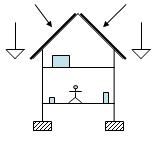Structural load facts for kids
Structural loads or actions are forces, deformations, or accelerations applied to a structure or its components. A load is the amount of weight a structure has to carry. Loads cause stresses, deformations, and displacements in structures. Structural analysis is the calculation of the effects of loads on physical structures. Excess load or overloading may cause structural failure. This is a consideration in the design and construction of a structure.
Mechanical structures, such as aircraft, satellites, rockets, space stations, ships and submarines, have their own particular structural loads and actions. In a vehicle, especially trucks, the chassis is designed to carry the structural load. In many cars unibody construction is used where the metal skin (or other materials) is designed to carry the load.
Gravity on Earth is an attractive force that affects all objects. A gravity load is one that the downward force of gravity affects.
Structural loads
The following are typical loads exerted against most structures:
- Dead load is the load that permanently acts on the structure. It includes the structure itself. A dead load is a gravity load.
- Live load is anything the structure is designed to carry. Live loads may move within the structure exerting different loads in different parts of the structure at different times. They are not permanent. A live load may be furniture and people in a building. It may be passengers and luggage in a vehicle.
- Wind load is the force of wind against the surface of a structure. Wind loads are horizontal lateral forces. Wind load is very important in the design of taller buildings. Wind shear is a force that may affect structures vertically or horizontally. Uplift is a negative force caused by wind. It may cause a roof to lift upward.
- Snow load is the load caused by snow. Similar to a live load is it not permanent and may move due to wind causing snow to drift on a roof.
Other environmental loads
- Seismic loads
- Temperature changes leading to thermal expansion cause thermal loads
- Ponding loads
- Frost heaving
- Lateral pressure of soil, groundwater or bulk materials
- Loads from fluids or floods
- Permafrost melting
Aircraft structural loads
For aircraft, loading is divided into two major categories: limit loads and ultimate loads. Limit loads are the maximum loads a component or structure may carry safely. Ultimate loads are the limit loads times a factor of 1.5 or the point beyond which the component or structure will fail. Gust loads are determined statistically and are provided by an agency such as the Federal Aviation Administration. Crash loads are loosely bounded by the ability of structures to survive the deceleration of a major ground impact. Other loads that may be critical are pressure loads (for pressurized, high-altitude aircraft) and ground loads. Loads on the ground can be from adverse braking or maneuvering during taxiing. Aircraft are constantly subjected to cyclic loading. These cyclic loads can cause metal fatigue.
See also
 In Spanish: Carga estructural para niños
In Spanish: Carga estructural para niños



